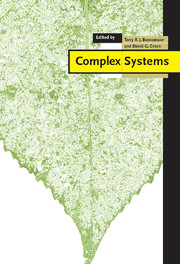Book contents
- Frontmatter
- Contents
- 1 Introduction
- 2 Self-organisation in complex systems
- 3 Network evolution and the emergence of structure
- 4 Artificial life: growing complex systems
- 5 Deterministic and random fractals
- 6 Non-linear dynamics
- 7 Non-linear control systems
- 8 Parallel computers and complex systems
- 9 Are ecosystems complex systems?
- 10 Complexity and neural networks
- Index
2 - Self-organisation in complex systems
Published online by Cambridge University Press: 04 August 2010
- Frontmatter
- Contents
- 1 Introduction
- 2 Self-organisation in complex systems
- 3 Network evolution and the emergence of structure
- 4 Artificial life: growing complex systems
- 5 Deterministic and random fractals
- 6 Non-linear dynamics
- 7 Non-linear control systems
- 8 Parallel computers and complex systems
- 9 Are ecosystems complex systems?
- 10 Complexity and neural networks
- Index
Summary
Introduction
How does a spider, with no knowledge of geometry, create the symmetry of its web? How do millions of nearly identical cells organise themselves into living creatures? Questions such as these remain some of the deepest mysteries, and greatest challenges, of modern science. The mere term ‘organism’ expresses the fundamental roles that interactions, selforganisation and emergent behaviour play in all biological systems.
Organisation arises from several sources. External constraints, such as biochemical gradients limiting cell activity, or money supply controlling economic activity, have been intensively studied in many disciplines. In this chapter we address the less understood question of self-organisation. That is, how do intrinsic properties, interactions between elements and other factors act to create order within complex systems?
The question of self-organisation is one of the central issues in the study of complexity. Early pioneers such as von Bertalanffy (1968) recognized the importance of internal interactions and processes as sources of organization and order. The resulting ‘general systems theory’ drew on analogies to point to the existence of common processes in superficially different systems. The need to plan complex military operations during World War II, and especially the coordination of many inter-dependent elements, provided the origins for systems analysis, operations research and related bodies of theory. In the years following the War these ideas contributed to the development of important fields, such as engineering and business management. However it was many years before the importance of systems thinking filtered into mainstream science, especially biology, which even now remains largely reductionist.
Perhaps the greatest puzzle in self-organisation is the question of emergent properties.
- Type
- Chapter
- Information
- Complex Systems , pp. 11 - 50Publisher: Cambridge University PressPrint publication year: 2000
- 3
- Cited by



